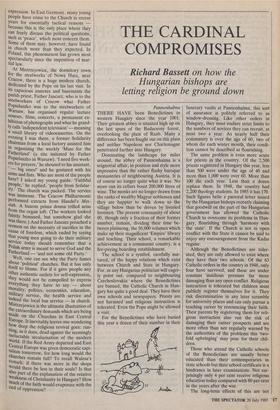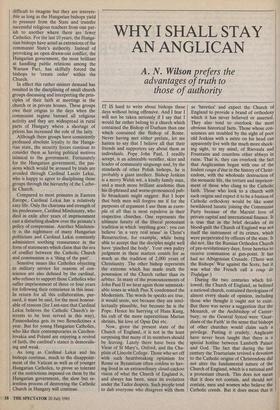THE CARDINAL COMPROMISES
Richard Bassett on how the Hungarian bishops are letting religion be ground down
Pannonhalma THERE HAVE been Benedictines in western Hungary since the year 1001. Their greatest abbey is situated high up on the last spurs of the Badacsony forest, overlooking the plain of Raab. Many a difference has been fought out on this plain and neither Napoleon nor Charlemagne penetrated further into Hungary. Dominating the landscape for miles around, the abbey of Pannonhalma is a seignorial affair, in position and style more impressive than the rather flashy baroque monasteries of neighbouring Austria. It is of course no longer quite what it was. No more can its cellars boast 200,000 litres of wine. The monks are no longer drawn from the ranks of wealthy Magyar noblemen and they are happier to walk down to the village below than be driven by liveried footmen. The present community of about 80, though only a fraction of their former number, remain, dividing their time be- tween plainsong, the 50,000 volumes which make up their magnificent 'Empire' library and teaching. Their school, a remarkable achievement in a communist country, is a fee-paying boarding establishment.
The school is a symbol, carefully nur- tured, of the happy relations which exist between Church and State in Hungary. For, as any Hungarian politician will eager- ly point out, compared to neighbouring Czechoslovakia where the Benedictines are banned, the Catholic Church in Hun- gary has quite a good deal. They have their own schools and newspapers. Priests are not harassed and religious instruction is tolerated. Even the Pope might be allowed a visit.
For the Benedictines who have buried this year a dozen of their number in their funerary vaults at Pannonhalma, this sort of assurance is politely referred to as window-dressing. Like other orders in Hungary, they must endure strict limits to the numbers of novices they can recruit, at most two a year. As nearly half their community is over the age of 60, two of whom die each winter month, their condi- tion cannot be described as flourishing.
The same problem is even more acute for priests in the country. Of the 2,500 priests registered in Hungary this year, less than 500 were under the age of 40 and more than 1,000 were over 60. More than 100 die each year. Less than a dozen replace them. In 1948, the country had 2,200 theology students. In 1985 it has 170. Such figures belie a pastoral letter issued by the Hungarian bishops recently claiming that goodwill on the part of the Hungarian government has allowed the Catholic Church to overcome its problems in Hun- gary, flourishing through 'harmony with the state'. If the Church is not in open conflict with the State it cannot be said to enjoy any encouragement from the Kadar regime.
Although the Benedictines are toler- ated, they are only allowed to exist where they have their two schools. Of the 63 Catholic orders in the country in 1948, only four have survived, and these are under constant insidious pressure far more damaging than any open conflict. Religious instruction is tolerated but children must publicly register themselves for it. They risk discrimination in any later scramble for university places and can only pursue a teaching career by renouncing their faith. Their parents by registering them for reli- gious instruction also run the risk of damaging their career prospects and are more often than not regularly warned by the authorities of the problems this 'two- fold upbringing' may pose for their chil- dren.
Those who attend the Catholic schools of the Benedictines are usually better educated than their contemporaries in state schools but their school certificate is a hindrance in later examinations. Not sur- prisingly only 4 per cent receive religious education today compared with 80 per cent in the years after the war.
The long-term effects of this are not difficult to imagine but they are irrevers- ible as long as the Hungarian bishops yield to pressure from the State and transfer successful religious teachers from one par- ish to another where there are fewer Catholics. For the last 10 years, the Hunga- rian bishops have acted as extensions of the communist State's authority, Instead of provoking an open drawn-out conflict, the Hungarian government, the most brilliant at handling public relations among the Warsaw Pact, has skilfully forced the bishops to 'create order' within the Church.
In effect this rather sinister demand has resulted in the disciplining of small church groups discussing and interpreting the prin- ciples of their faith at meetings in the church or in private houses. These groups owe their origins to the days when the communist regime banned all religious activity and they are widespread in rural parts of Hungary where a shortage of priests has increased the role of the laity.
Although these groups have consistently professed absolute loyalty to the Hunga- rian state, the security forces continue to consider them as having political motives inimical to the government. Fortunately for the Hungarian government, the pas- sions which would be aroused by trials are avoided through Cardinal Laszlo Lekai, who is happy to agree to disciplining these groups through the hierarchy of the Catho- lic Church.
Compared to most primates in Eastern Europe, Cardinal Lekai has a relatively easy life. Only the charisma and strength of his predecessor, Cardinal Mindszenty, who died in exile after years of imprisonment cast a disturbing shadow over the primate's policy of compromise. Another Mindszen- ty is the nightmare of many Hungarian politicians and Cardinal Lekai constantly administers soothing reassurance in the form of statements which claim that the era of conflict between the Catholic Church and communism is a 'thing of the past'.
Sensitive issues like Catholics objecting to military service for reasons of con- science are also defused by the cardinal, who refuses to support those Catholics who suffer imprisonment of three or four years for following their conscience in this issue. In return for all this collaboration, pur- sued, it must be said, for the most honour- able of reasons (for I am sure that Cardinal Lekai believes the Catholic Church's in- terests to be best served in this way), Pannonhalma gets its two Benedictines a year. But for young Hungarian Catholics, who like their contemporaries in Czechos- lovakia and Poland are enjoying a revival of faith, the cardinal's stance is demoralis- ing and weak.
As long as Cardinal Lekai and his bishops continue, much to the disappoint- ment of the Vatican as well as of younger Hungarian Catholics, to prove so tolerant of the restrictions imposed on them by the Hungarian government, the slow but re- lentless process of destroying the Catholic Church in Hungary will continue.



















































 Previous page
Previous page